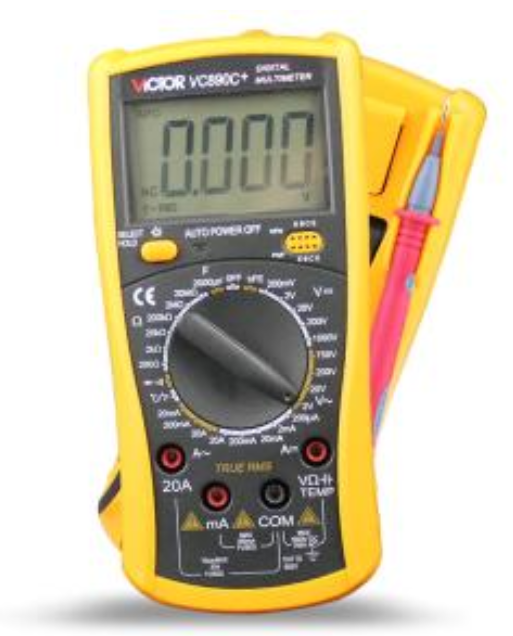Digital multimeters are widely used in national defense, scientific research, factories, schools, metrology and testing, etc. due to their high accuracy, wide measuring range, fast measuring speed, small size, strong anti-interference ability and convenient use. Different, performance indicators are diverse, the use environment and working conditions are also different, so you should choose the appropriate digital multimeter according to the specific situation.

The choice of a digital multimeter is generally considered from the following aspects:
First, the function
In addition to five functions, such as measuring AC, DC voltage, AC, DC current, and resistance, the digital multimeter also has digital calculation, self-test, reading hold, error readout, diode detection, word length selection, IEEE-488. Interface or RS-232 interface and other functions, should be selected according to specific requirements.
Second, the scope and range
Digital multimeters have many ranges, but their basic range accuracy is the highest. Many digital multimeters have an autoranging function that eliminates the need to manually adjust the range, making measurement easy, safe, and fast. There are also many digital multimeters that have over-range capability. When the measured value exceeds the range but the maximum display has not yet reached the maximum display, the range cannot be changed, thus improving the accuracy and resolution.
Third, accuracy
The maximum error allowed by a DMM depends not only on its variable term error, but also on its fixed term error. When choosing, it depends on the requirements of the stability error and linearity error, and whether the resolution meets the requirements. General digital multimeters require 0.0005 to 0.002, at least 61 digits; 0.005 to 0.01, at least 51 digits; 0.02 to 0.05, at least 41 digits; 0.1 Below, there should be at least 31 digits displayed.
Fourth, input resistance and zero current
The input resistance of the DMM is too low and the zero current is too high, which will cause measurement error. The key depends on the limit value allowed by the measuring device, that is, the internal resistance of the signal source. When the source impedance is high, the instrument with high input impedance and low zero current should be selected to make the influence negligible.
Five, series mode suppression ratio and common mode rejection ratio
In the presence of various disturbances such as electric fields, magnetic fields and various high-frequency noises or long-distance measurement, it is easy to mix in the interference signal, resulting in inaccurate readings. Therefore, the instrument with high string rejection ratio should be selected according to the use environment, especially When performing high-precision measurement, the digital multimeter with the protection terminal G should be selected to suppress the common mode interference.
Sixth, display form and power supply
Digital DMMs are not limited to numbers, but can also display charts, text, and symbols for on-site observation, operation, and management. According to the size of its display device, it can be divided into four categories: small, medium, large and super large.
The power supply for digital multimeters is typically 220V, and some new digital multimeters have a wide range of power supplies ranging from 1100V to 240V. Some small digital multimeters can be used with batteries, and some digital multimeters can be used in alternating current, internal nickel-cadmium batteries or external batteries.
Seven, response time, measurement speed, frequency range
The shorter the response time, the better, but some tables have a longer response time, and the reading will not stabilize until after a while. The speed of measurement should be based on whether it is used in conjunction with system testing. For example, speed is important, and the faster the better. The frequency range is appropriately selected as needed.
Eight, AC voltage conversion form
AC voltage measurement is divided into average conversion, peak conversion and rms conversion. When the waveform distortion is large, the average conversion and peak conversion are inaccurate, and the RMS conversion is not affected by the waveform, making the measurement result more accurate.
Nine, resistance wiring
The resistance measurement wiring method has a four-wire system and a two-wire system. For small resistance and high-precision measurement, a four-wire resistance measurement wiring method should be selected.
With the development of large-scale integrated circuits and display technologies, digital multimeters are gradually moving toward miniaturization, low power consumption, and low cost. Digital multimeters are also clearly classified into portable and desktop. Portable is generally 31 or 41, small size, light weight, low power consumption, suitable for production workshop or field use; desktop can be 61 or 71, with higher accuracy and resolution, using microprocessor and The GP-IB interface device is used as a standard meter and precision measurement in the measurement, scientific research and production departments.
In short, it is not necessary to have all of the above conditions when selecting, and the most appropriate digital multimeter should be selected according to the specific requirements used.
Oilfield Gas Generator,Gas Power Generator,Green Power Gas Generator,Small Gas Generator
Jiangsu Vantek Power Machinery Co., Ltd , https://www.vantekpower.com